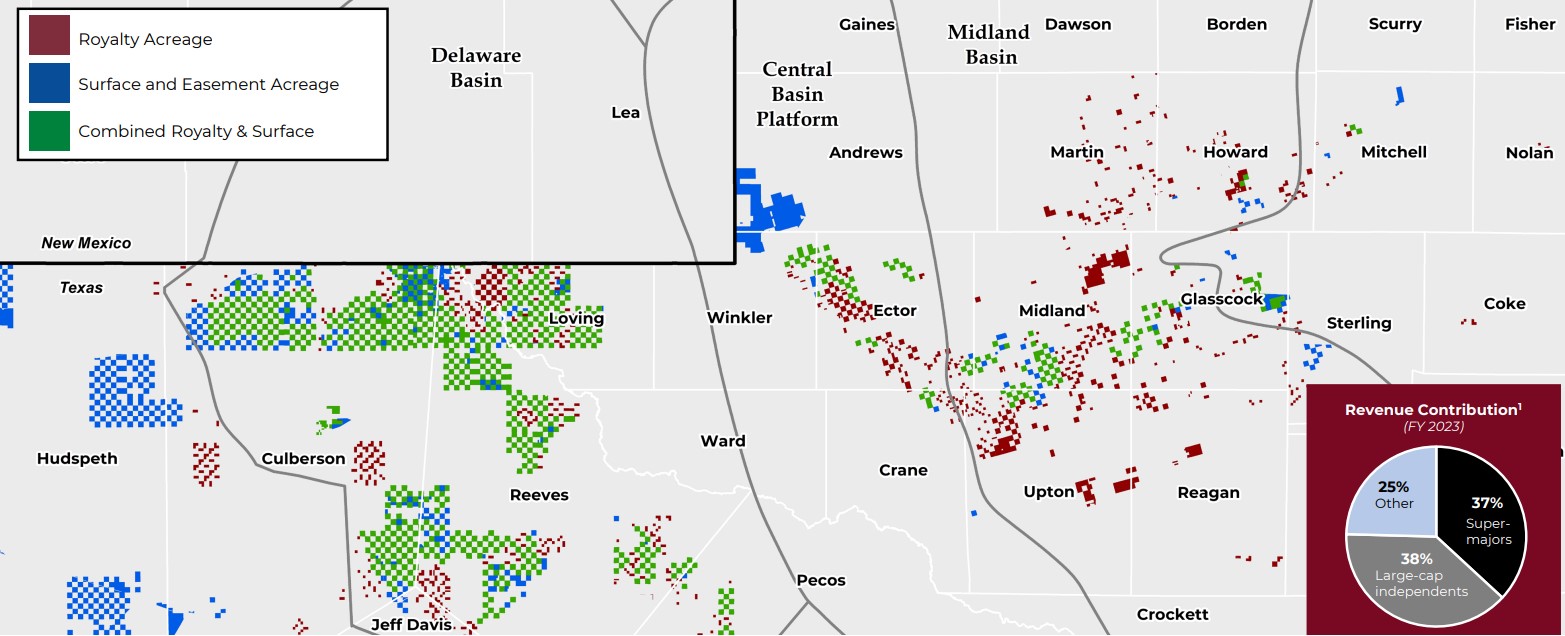
As more public and private capital pours into the space and teams get increasingly sophisticated, the minerals sector is poised to grow. (Source: Shutterstock)
Public mineral and royalty aggregators are growing bigger than ever—but experts say they need to get even larger to become household names among generalist investors.
Recruiting investors back to the energy sector is top of mind for bankers like Tim Perry, who joined RBC as vice chairman of global energy last year after spending over two decades at Credit Suisse.
He watched the energy sector’s share in the S&P 500 decline to a fraction of its former weighting; the energy sector makes up just 4% of the broader index today.
“The number of energy investors, funds or energy investors within a very large fund—like a Fidelity or a Wellington—have really hugely shrunk in the industry,” Perry said during the World Oilman’s Mineral & Royalty Conference in April.
Investors haven’t turned their noses up at the energy industry without reason. Innovation in horizontal drilling and fracking kicked off the U.S. shale boom. Operators were being rewarded to grow production at any cost, even if that meant regularly outspending cash flows.
Unprofitable drilling ventures, debt-laden balance sheets, multiple oil-price busts and the COVID-19 pandemic led to waves of bankruptcies. Investor faith in oil and gas eroded over time; capital flowing into the sector eroded away, too.
Oil and gas companies, however, have started to get with the program. They’re generating healthy volumes of free cash flow—record amounts for many companies—and returning as much cash to investors as possible through dividends and share buybacks.
E&Ps have been among the best-performing stocks emerging from the pandemic: The S&P XOP (Oil & Gas E&P) index grew about 170% since January 2021. The broader S&P 500 grew around 36% over the same period.

But yield-oriented investors should also pay attention to oil and gas mineral and royalty stocks, which have grown around 130% over the period, according to RBC’s analysis.
Minerals companies are relatively safe investments compared to E&Ps, Darin Zanovich, president and CEO of Mesa Minerals III, told Oil & Gas Investor.
Minerals companies aren’t exposed to drilling and completion risks. But for E&Ps, D&C costs can pile up.
Minerals players essentially make a one-time purchase to own the subsurface interests in perpetuity. E&Ps must then go out and negotiate a lease for those subsurface interests—and the lease eventually expires.
As more public and private capital pours into the space and teams get increasingly sophisticated, the minerals sector is poised to grow.
“It used to be that there was an oil and gas space: an E&P side and a midstream side,” Zanovich said. “Really we’ve created this new asset class: minerals and royalties.”
RELATED
Mesa III Reloads in Haynesville with Mineral, Royalty Acquisition
Scale & sales
Activity by public and private minerals and royalties aggregators, like NGP-backed Mesa Minerals III, has picked up notably. Earlier this year, Mesa closed an acquisition of around 6,200 net royalty acres in the core of the Haynesville Shale.
Minerals and royalties activity has also picked up relatively recently: The market value of public minerals companies has doubled to around $30 billion since 2019, by RBC’s analysis.
The public minerals and royalties market is led by Texas Pacific Land, which boasts a market cap of around $13 billion. The company traces its roots to the properties held by the Texas and Pacific Railway, which crossed through the core of the Permian Basin.

Viper Energy Partners (market cap ~$7 billion) is another player growing in the minerals and royalties space. Viper was formed by Permian operator Diamondback Energy to acquire mineral and royalty interests in oil-weighted basins, mainly the Permian.
Diamondback served as operator for around half of Viper’s net royalty acreage by the end of 2023, according to regulatory filings.
Late last year, Viper acquired Permian interests from GRP Energy Capital and Warwick Capital partners for about $1 billion in cash and stock—one of the largest deals transacted in the minerals and royalties space.
The merger between Sitio Royalties and Brigham Minerals, closed in late 2022, was another one of the largest transactions inked in the space to date. Sitio’s market value is around $3.7 billion today.
Natural gas-weighted Black Stone Minerals (market cap ~$3.7 billion) holds a significant foothold in the Haynesville and Bossier plays in East Texas and Louisiana.
The public minerals market also includes Kimbell Royalty Partners (~$1.6 billion), Dorchester Minerals (~$1.3 billion) and PHX Minerals (~$125 million)—each of which have been active buyers in basins around the Lower 48.
Doubling the market value of minerals companies to $30 billion over the past five years is great. It’s still not good enough to attract the level of investment that the sector argues it deserves.
That $30 billion total still isn’t that large, and only Texas Pacific Land has a market value north of $10 billion, Perry said. The minerals pie needs to grow even larger.
“Investors want size,” Perry said. “Not only size in market cap, but they also want size in trading liquidity.”
Experts believe the minerals and royalties market is ripe for additional consolidation, and market players are working to make deals happen.
Last year, PHX Minerals rejected an offer to combine with privately held WhiteHawk Energy LLC to yield a larger public minerals player. The PHX board unanimously determined that the proposal was “grossly inadequate in terms of the value offered to PHX and its stockholders.”
The minerals pie certainly also has room to grow with more public companies, Perry said. But IPO activity for oil and gas E&Ps, let alone minerals and royalties companies, has been quite muted since the pandemic.
A small handful of E&P and services-related IPOs transacted last year, including MLPs TXO Partners and Mach Natural Resources.
Two companies in the services space—contract compression provider Kodiak Gas Services and frac sand specialist Atlas Energy Solutions—also went public last year.
Barnett Shale E&P BKV Corp. is another private producer aiming to IPO but still in wait for improvements in the natural gas market.
There’s been even less investor appetite for minerals IPOs, but that could change as additional E&P IPOs start to cross the finish line, Perry said.
But investors still want scale, so private minerals companies should aggregate and scale up before approaching the public markets to go public, he said.
“There are some sizable companies that are thinking about doing IPOs,” Perry said. “We’ve had inquiries here this year.”
RELATED
BKV CEO: Barnett E&P Waits for Right Window to Launch IPO
Permian focus
A record amount of corporate E&P M&A activity last year centered on the Permian Basin of West Texas and New Mexico.
The Midland Basin saw over $100 billion in dealmaking, including Exxon Mobil’s massive $60 billion takeover of Pioneer Natural Resources and Diamondback’s $26 billion acquisition of Endeavor Energy Resources.
Exxon closed the Pioneer deal in early May, but Diamondback’s acquisition of Endeavor is facing regulatory scrutiny by the U.S. Federal Trade Commission.
As minerals players look to race ahead of the drill bit, they’re also focusing on the Permian Basin.
Permian mineral dealmaking accelerated in the past two years:
Brigham Minerals acquired a Midland Basin package from Avant Natural Resources for around $132.5 million in 2022.
Kimbell Royalty Partners acquired Permian interests, mostly in the Delaware, from Hatch Royalty for $290 million in 2022. KRP followed on with a $143 million deal in the northern Midland Basin with MB Minerals, a subsidiary of Sabalo Holdings.
Canadian player Freehold Royalties acquired northern Midland Basin interests, mostly in Howard County, Texas, for $123 million in 2022;
Coal company Alliance Resource Partners LP upped its oil and gas mineral acreage in the Permian with $150 million in acquisitions in early 2023;
Playing in the Permian isn’t cheap, however. To buy into zones of the Permian that have a high likelihood of being drilled, you’ll need to pay a premium.
The average value of Permian mineral and royalty interests—the price per net royalty acre a buyer is paying to acquire the interest—has climbed significantly over the last several years, according to an analysis by Detring Energy Advisors.
As a greater portion of the Permian gets developed and output increases, dollar-per-net royalty acre ($/NRA) values will continue to climb due to an increasing share of flowing production value.
“As these basins become more and more developed with PDP and near-term activity, you’re just getting a lot more next-twelve-months cash flow out of those royalty acres,” said President Derek Detring.
In years past, Permian minerals transactions would trade within a band of between $10,000 and $20,000 per net royalty acre.
Deals in the core of the Permian fetch much higher prices than deals on the fringes of the play. Consider two of Kimbell’s Permian acquisitions last year.
Its $143 million deal with Sabalo included 806 net royalty acres (6,445 NRA normalized to a standard 1/8th royalty rate) in Howard and Borden counties, Texas, in the northern Midland Basin.
The area features notably high oil cuts; KRP’s deal included assets that were 77% oil-weighted. But the northern Midland Basin, dominated by players like Surge Energy, HighPeak, SM Energy, Birch Operations and EOG Resources, is largely considered outside of the basin’s core.
KRP paid around $22,200 per NRA for the Sabalo deal.
Now consider KRP’s $290 million acquisition from Hatch Royalties in the Delaware Basin.
Hatch’s assets included 889 net royalty acres (7,100 normalized to 1/8th), mostly concentrated in the Texas Delaware Basin. The deal included acreage in the core-of-the-core of the play: Loving County, Texas, and Lea and Eddy counties, New Mexico.
“That’s a really good part of the country—I’d say the best zip code in the Lower 48,” Detring said.
KRP paid over $40,000 per NRA for the Hatch Royalty acquisition.
Detring claims to have advised on the two highest $/NRA minerals transactions in the Lower 48: Both deals were in the Permian and traded at over $55,000 per NRA.
RELATED
Life on the Edge: Surge of Activity Ignites the Northern Midland Basin
Recommended Reading
Trying to Keep Tabs on the Inflation Reduction Act’s $370B
2025-01-08 - Several online trackers are following the flow of Inflation Reduction Act money, but a full accounting of the billions already obligated by the Biden administration is a monumental task.
Report: Trump to Declare 'National Energy Emergency'
2025-01-20 - President-elect Donald Trump will also sign an executive order focused on Alaska, an incoming White House official said.
Uncertainty Abounds: IRA Clean Energy Incentives Await Fate
2025-01-05 - Policy experts weigh in on the next possible steps for President Joe Biden’s signature climate law, the Inflation Reduction Act, following the Trump-led Republican trifecta.
Big Spenders: EPA Touts Billions in Clean Energy Spending
2025-01-15 - Nearly $69 billion in funding from the Inflation Reduction Act and Bipartisan Infrastructure Law has been dispersed by the Environmental Protection Agency in its clean energy push.
Comments
Add new comment
This conversation is moderated according to Hart Energy community rules. Please read the rules before joining the discussion. If you’re experiencing any technical problems, please contact our customer care team.




